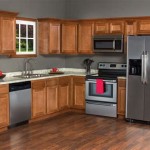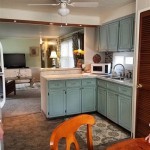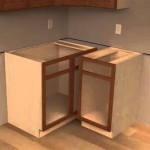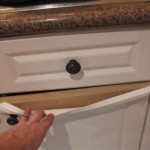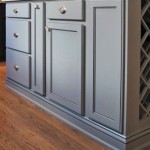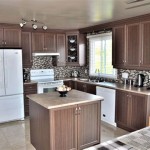What Color Is Best For Inside Kitchen Cabinets?
The selection of a color for the interior of kitchen cabinets is a frequently overlooked aspect of kitchen design. While the exterior cabinet doors and frames significantly influence the overall aesthetic, the interior color plays a crucial role in functionality, perceived cleanliness, and the visual harmony of the space. Understanding the nuances of color psychology, practical considerations, and current design trends is essential for making an informed decision. There is no single "best" color, as the optimal choice depends on a variety of factors, including the kitchen's overall color scheme, the homeowner's personal preferences, and the desired atmosphere.
Several factors should be considered when determining the appropriate color for the interior of kitchen cabinets. These include the size of the kitchen, the amount of natural light available, the color of the exterior cabinets and countertops, and the homeowner's personal design preferences. Furthermore, the intended use of the cabinets, such as for storing food, dishes, or cookware, can also influence the color selection. Practical considerations, such as ease of cleaning and the ability to conceal minor imperfections, are also relevant.
The following discussion will explore various color options, highlighting their advantages and disadvantages, and providing guidance on selecting the most suitable color for individual kitchen designs.
Understanding the Role of Color Psychology
Color psychology is the study of how colors affect human behavior and emotions. Different colors evoke different feelings, and understanding these psychological effects is important when choosing a color for the interior of kitchen cabinets. While individual reactions to colors can vary based on personal experiences and cultural background, certain general associations are widely recognized.
White, for example, is often associated with cleanliness, purity, and spaciousness. It can create a bright and airy feel, making it a popular choice for smaller kitchens or those with limited natural light. However, white can also feel sterile or impersonal if not balanced with warmer tones. Moreover, white interiors can highlight dirt and stains more readily than darker colors, requiring more frequent cleaning.
Gray is a versatile and sophisticated color that can create a calming and neutral backdrop. It can be paired with a wide range of other colors, making it a flexible choice for various kitchen styles. Lighter shades of gray can mimic the spaciousness of white, while darker shades can add depth and drama. However, too much gray can feel cold or depressing, especially in kitchens with limited natural light.
Warm colors, such as yellow, orange, and red, can create a sense of energy and warmth. They can be particularly suitable for kitchens that are frequently used for social gatherings or family meals. However, these colors can also be overwhelming if used excessively. Subdued or muted versions of warm colors are often a better choice for cabinet interiors, as they provide a subtle warmth without being too visually stimulating.
Cool colors, such as blue, green, and purple, can create a calming and relaxing atmosphere. They are often associated with nature and serenity. Lighter shades of blue and green can create a refreshing and airy feel, while darker shades can add depth and sophistication. However, cool colors can also feel cold or impersonal if not balanced with warmer accents. Moreover, some shades of purple can clash with certain kitchen styles.
Ultimately, the best color for the interior of kitchen cabinets depends on the desired mood and atmosphere. Homeowners should consider the overall color scheme of the kitchen and choose a color that complements the existing design elements.
Exploring Popular Color Options and Their Practical Considerations
Several colors are commonly used for the interior of kitchen cabinets, each offering unique advantages and disadvantages. A thorough examination of these options, considering both aesthetic appeal and practical considerations, is crucial for making an informed decision.
White remains a popular choice due to its inherent brightness and ability to create a sense of spaciousness. It is particularly well-suited for smaller kitchens or those with limited natural light. White also provides a clean and neutral backdrop for displaying dishes, glassware, and other kitchen items. However, white cabinets require more frequent cleaning to maintain their pristine appearance. Dust, crumbs, and spills are readily visible, making it essential to wipe down the surfaces regularly. Furthermore, over time, white paint can yellow or discolor, especially in areas exposed to sunlight or grease. The specific type of white paint used can also affect its durability and susceptibility to staining. For example, semi-gloss or gloss finishes are generally easier to clean than matte finishes.
Gray is another versatile option that offers a more forgiving alternative to white. Lighter shades of gray can provide a similar sense of spaciousness, while darker shades can add depth and sophistication. Gray is also less likely to show dirt and stains than white, making it a more practical choice for busy kitchens. Furthermore, gray complements a wide range of other colors, making it a flexible option for various kitchen styles. However, it is important to choose the right shade of gray, as some shades can feel cold or depressing, especially in kitchens with limited natural light. Warm grays, with subtle undertones of beige or brown, can provide a more inviting and comfortable feel. Cool grays, with blue or green undertones, can create a more modern and sophisticated look.
Natural wood tones, such as maple, oak, or cherry, are a classic choice that can add warmth and character to any kitchen. Wood interiors provide a natural and organic feel, complementing a wide range of kitchen styles, from traditional to contemporary. They are also relatively durable and easy to maintain. However, wood interiors can darken over time, especially if exposed to sunlight. Furthermore, the specific type of wood used can affect its appearance and durability. Hardwoods, such as maple and oak, are generally more durable than softwoods, such as pine. The finish applied to the wood can also affect its appearance and resistance to staining. A clear finish will allow the natural beauty of the wood to shine through, while a stained finish can alter the color and tone.
Colored interiors, such as blue, green, or yellow, can add a pop of color and personality to the kitchen. These options can be particularly suitable for homeowners who want to create a unique and personalized space. However, it is important to use colored interiors sparingly, as they can be overwhelming if used excessively. Subdued or muted versions of these colors are often a better choice for cabinet interiors, as they provide a subtle accent without being too visually stimulating. Furthermore, the color should complement the overall color scheme of the kitchen. For example, blue interiors can work well with white or gray exteriors, while green interiors can complement natural wood tones.
Ultimately, the best color for the interior of kitchen cabinets depends on the homeowner's personal preferences and the overall design of the kitchen. Careful consideration of both aesthetic appeal and practical considerations is essential for making an informed decision.
Matching Interior Colors to Exterior Cabinets and Kitchen Style
The color of the interior of kitchen cabinets should complement the exterior cabinet doors and the overall style of the kitchen. A cohesive and harmonious design creates a more visually appealing and functional space. Coordinating interior and exterior colors requires careful consideration of color theory, design principles, and the specific characteristics of the kitchen.
For kitchens with white exterior cabinets, a white interior is a classic and reliable choice. This creates a seamless and unified look, enhancing the sense of spaciousness and brightness. Alternatively, a contrasting color, such as gray or a light wood tone, can add depth and visual interest. A light gray interior can provide a subtle contrast while still maintaining a clean and modern feel. Light wood tones can add warmth and character, complementing the white exterior. A bold color, such as blue or green, can be used for a more dramatic effect, but it is important to use it sparingly and ensure that it complements the overall color scheme.
For kitchens with dark exterior cabinets, such as black, navy, or dark gray, a lighter interior is often preferred. A white or light gray interior can provide a stark contrast, highlighting the beauty of the dark exteriors and preventing the cabinets from feeling too heavy or overwhelming. A light wood tone can also work well, adding warmth and natural texture to the space. Avoid using dark interiors with dark exteriors, as this can create a gloomy and claustrophobic feel. If a dark interior is desired, it should be used sparingly and balanced with plenty of light.
For kitchens with natural wood exterior cabinets, such as maple, oak, or cherry, a matching wood interior is a common choice. This creates a cohesive and traditional look, enhancing the natural beauty of the wood. Alternatively, a contrasting color, such as white or gray, can be used to create a more modern and updated feel. A white interior can provide a clean and bright contrast, while a gray interior can add a touch of sophistication. Consider the specific wood tone when selecting a contrasting color. For example, a light maple exterior can pair well with a light gray interior, while a dark cherry exterior may benefit from a white interior.
The overall style of the kitchen should also be considered when selecting interior cabinet colors. For traditional kitchens, a matching wood interior or a classic white interior is often the best choice. For modern kitchens, a contrasting color, such as gray or a bold color, can add a touch of contemporary flair. For farmhouse kitchens, a white or light wood interior can create a warm and inviting feel. Consider the existing design elements of the kitchen, such as the countertops, backsplash, and flooring, when selecting interior cabinet colors. The colors should complement each other and create a harmonious and balanced space.
Ultimately, the best approach is to experiment with different color combinations and consider how they look in the specific kitchen environment. Paint samples and visualizers can be helpful tools for making informed decisions.

14 Kitchen Cabinet Color Combinations To Try

What Color Should You Paint The Inside Of Kitchen Cabinets

Fabulous Kitchen Cabinets Colours And Styles In 2024

Which Colours Are Good For Kitchens As Per Vastu

70 Top Kitchen Paint Colors Best 2024

Top 10 Kitchen Cabinets Colors Which Are In Demand 2024

How To Choose Kitchen Cabinet Paint Colors

How To Paint Inside Kitchen Cabinets In 7 Steps Benjamin Moore

21 Kitchen Cabinet Ideas Paint Colors Inspiration Benjamin Moore

House Home 70 Kitchens That Make A Case For Color
Related Posts

